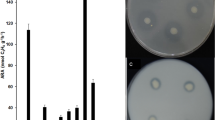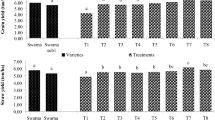Abstract
Rice (Oryza sativa L.) is a staple food for more than two billion people worldwide. Its cultivation demands large amounts of nutrients, particularly nitrogen and phosphorus (P). Consequently, low availability of these nutrients in the soil has led to the use of chemical fertilizers, generating increases in production costs and environmental damage. Soil host microorganisms known as plant growth-promoting rhizobacteria (PGPR) colonize the rhizosphere and facilitate the uptake of nutrients by the plants. In this study, rice seeds inoculated with PGPR were grown for 30 days in an inert substrate and fertilized with modified Hoagland nutrient solution with phosphate rock as a source of P. Treatments were repeated over time, obtaining five isolates which significantly increased plant length by up to 56% and dry weight of stems and roots up to 45% and 169% respectively relative to an uninoculated control. Selected strains showed in vitro tri-calcium phosphate solubilizing activity, mineralizing phytate activity, and phosphate release from rice straw (RS). Based on the above criteria, three isolates (IBUN-02755, -02,704 and -02,724) that contained β propeller phytase (BPP) genes, were selected to evaluate their effect as PGPR in rice seedlings. These were planted in a soil amended with RS under greenhouse conditions. The results showed that selected Bacillus spp. strains significantly increased plant length and dry weight or increased plant phosphate uptake up to two times compared to an un-inoculated control. This suggests that selected strains may have a capacity as PGPR using RS as carbon and a P amendment.



Similar content being viewed by others
References
Prasanna R, Nain L, Pandey A, Nayak S (2010) Exploring the ecological significance of microbial diversity and networking in the rice ecosystem. In: Dion P (ed) Soil Biology and Agriculture in the Tropics. Springer-Verlag, Berlin, pp 139–161
FAO (2018) FAO rice market monitor. http://www.fao.org/economic/est/publications/rice-publications/rice-market-monitor-rmm/en/. Accessed 27 April 2018.
Zeigler R, Barclay A (2008) The relevance of rice. Rice 1:3–10
Ye T, Li Y, Zhang J, Hou W, Zhou W, Lu J, Xing Y, Li X (2019) Nitrogen, phosphorus, and potassium fertilization affects the flowering time of rice (Oryza sativa L). Glob Ecol Conserv 20:e00753
Zhu J, Li M, Whelan M (2018) Phosphorus activators contribute to legacy phosphorus availability in agricultural soils: A review. Sci Total Environ 612:522–537
Dash N, Pahari A, Dangar TK (2017) Functionalities of Phosphate-Solubilizing Bacteria of Rice Rhizosphere: Techniques and Perspectives. In: Shukla P. (ed) Recent advances in Applied Microbiology. Springer, Singapore
Sanguin H, Wilson NL, Kertesz MA (2016) Assessment of functional diversity and structure of phytate-hydrolysing bacterial community in Lolium perenne rhizosphere. Plant Soil 401:151–167
Mukhametzyanova A, Akhmetova A, Sharipova M (2012) Microorganisms as phytase producers. Microbiology 81(3):291–300
Singh B, Satyanarayana T (2012) Plant growth promotion by phytases and phytase-producing microbes due to amelioration in phosphorus availability. In: Satyanarayana T, Johri BN, Prakash A (eds) Microorganisms in Sustainable Agriculture and Biotechnology. Springer, Netherlands, pp 3–15
George TS, Hinsinger P, Turner BL (2016) Phosphorus in soils and plants-facing phosphorus scarcity. Plant Soil 401(1–2):1–6
Van-Hung N, Maguyon-Detras MC, Migo MV, Quilloy R, Balingbing C, Chivenge P, Gummert M (2020) Rice Straw Overview: Availability, Properties, and Management Practices. In: Gummert M, Van-Hung N, Chivenge P, Douthwaite (ed) Sustainable rice straw management. Springer Nature Open Switzerland, pp 1–13.
Suriyagoda L, De Costa WAJM, Lambers H (2014) Growth and phosphorus nutrition of rice when inorganic fertiliser application is partly replaced by straw under varying moisture availability in sandy and clay soils. Plant Soil 384:53–68
Gadde B, Bonnet S, Menke C, Garivait S (2009) Air pollutant emissions from rice straw open field burning in India Thailand and the Philippines. Environ Pollut 157(5):1554–1558
Kumar P, Kumar S, Joshi L (2015) Socioeconomic and Environmental Implications of Agricultural Residue Burning: a Case Study of Punjab. Springer Briefs in Environmental Science, Punjab, India, India
Dobermann A, Fairhurst T (2002) Rice straw management. BCI 16 (Special Supplement) 7–11.
Uribe D, Sánchez-Nieves J, Vanegas J (2010) Role of microbial biofertilizers in the development of a sustainable agriculture in the tropics. In: Dion P (ed) Soil Biology and Agriculture in the Tropics. Springer-Verlag, Berlin, pp 235–250
Wei Y, Zhao Y, Shi M, Cao Z, Lu Q, Yang T, Fan Y, Wei Z (2018) Effect of organic acids production and bacterial community on the possible mechanism of phosphorus solubilization during composting with enriched phosphate-solubilizing bacteria inoculation. Bioresour Technol 247:190–199
Singh B, Boukhris I, Pragya, Kumar V, Yadav AN, Farhat-Khemakhem A, Kumar A, Singh D, Blibech M, Chouayekh H, Alghamdi OA (2020) Contribution of microbial phytases to the improvement of plant growth and nutrition: a review. Pedosphere 30(3):295–313
Patten C, Glick B (2002) Role of Pseudomonas putida indoleacetic acid in development of host plant root system. Appl Environ Microbiol 68:3795–3801
Shalini T, Vivek P, Charu L (2019) Bacillus: Plant Growth Promoting Bacteria for Sustainable Agriculture and Environment. In: Shankar J, Singh DP (ed) New and Future Developments in Microbial Biotechnology and Bioengineering. Elsevier, pp 43–55.
Sharma P, Bajaj BK (2015) Production of poly–hydroxybutyrate by Bacillus cereus PS 10 using biphasic-acid-pretreated rice straw. Int J Biol Macromol 79:704–710
Zhu Z, Zhang G, Luo Y, Ran W, Shen Q (2012) Production of lipopeptides by Bacillus amyloliquefaciens XZ-173 in solid state fermentation using soybean flour and rice straw as the substrate. Bioresour Technol 112:254–260
Posada-Uribe LF, Romero-Tabarez M, Villegas-Escobar V (2015) Effect of medium components and culture conditions in Bacillus subtilis EA-CB0575 spore production. Bioprocess Biosyst Eng 38:1879
Vanegas J, Uribe-Vélez D (2014) Selection of mixed inoculants exhibiting growth-promoting activity in rice plants from undefined consortia obtained by continuous enrichment. Plant Soil 375:215–227
Hoagland DR, Arnon DI (1950) The water-culture method for growing plants without soil. Calif Agr Exp Sta Cir 347:1–32
Nautiyal CS (1999) An efficient microbiological growth medium for screening phosphate solubilizing microorganisms. FEMS Microbiol Lett 170:265–270
Li G, Wu X, Ye J, Hou L, Zhou A, Zhao L (2013) Isolation and identification of phytate-degrading rizobacteria with activity of improving growth of poplar and Masson pine. World J Microbiol Biotechnol 29:2181–2193
Ordoñez YM, Fernández BR, Lara LS, Rodríguez A, Uribe-Vélez D, Sanders IR (2016) Bacteria with phosphate solubilizing capacity alter mycorrhizal fungal growth both inside and outside the root and in the presence of native microbial communities. PLoS One 11(6):1–18
Glickmann E, Dessaux Y (1995) A critical examination of the specificity of the Salkowski reagent for indolic compounds produced by phytopathogenic bacteria. Appl Environ Microbiol 61(2):793–796
Cruz-Ramírez C, Gómez-Ramírez L, Uribe-Vélez D (2017) Bio-based management of rice straw under different C:N ratios using microbial co-inocula and plant growth promoters. Rev Colomb Biotecnol 19(2): 47–62. https://doi.org/https://doi.org/10.15446/rev.colomb.biote.v19n2.70168
Sambrook JF, Russell DW (2001) Molecular Cloning: a Laboratory Manual, 3rd ed. Cold Spring Harbor Laboratory Press. pp 2100
Bray RH, Kurtz LT (1945) Determination of total, organic, and available forms of phosphorus in soils. Soil Sci 59(1):39–46
Ramesh A, Sharma S, Yadav N, Joshi O (2014) Phosphorus mobilization from native soil P-pool upon inoculation with phytate-mineralizing and phosphate-solubilizing Bacillus aryabhattai isolates for improved P-acquisition and growth of soybean and wheat crops in microcosm conditions. Agr Res 3(2):118–127
Rodushkin I, Ruth T, Huhtasaari A (1999) Comparison of two digestion methods for elemental determinations in plant material by ICP techniques. Anal Chim Act 378:191–200
Shao J, Xu Z, Zhang N, Shen Q, Zhang R (2015) Contribution of indole-3-acetic acid in the plant growth promotion by the rhizospheric strain Bacillus amyloliquefaciens SQR9. Biol Fertil Soils 51:321–330
Lim JH, Kim SD (2009) Synergistic plant growth promotion by the indigenous auxins-producing PGPR Bacillus subtilis AH18 and Bacillus licheniforims K11. J Kor Soc Appl Biol Chem 52:531–538
Etesami H, Alikhani HA, Hosseini HM (2015) Indole-3-acetic acid (IAA) production trait, a useful screening to select endophytic and rhizosphere competent bacteria for rice growth promoting agents. MethodsX 2:72–78
Chadwick AV, Burg SP (1967) An explanation of the inhibition of root growth caused by indole-3-acetic acid. Plant Physiol 42(3):415–420
Lavakush L, Yadav J, Verma J, Kumar D, Kumar A (2014) Evaluation of PGPR and different concentration of phosphorus level on plant growth, yield and nutrient content of rice (Oryza sativa). Ecol Eng 62:123–128
Shankar J (2013) Plant growth promoting rhizobacteria: potential microbes for sustainable agriculture. Resonance 18(3):275–281
Habibi S, Djedidi S, Prongjunthuek K, Mortuza M, Ohkama-Ohtsu N, Sekimoto H, Yokoyoma T (2014) Physiological and genetic characterization of rice nitrogen fixer PGPR isolated from rhizosphere soils of different crops. Plant Soil 379:51–66
Cherchali A, Boukhelata N, Kaci Y, Abrous-Belbachir O, Djebbar R (2019) Isolation and identification of a phosphate-solubilizing Paenibacillus polymyxa strain GOL 0202 from durum wheat (Triticum durum Desf) rhizosphere and its effect on some seedlings morphophysiological parameters. Biocatal Agric Biotechnol 19:101087
Valetti L, Iriarte L, Fabra A (2018) Growth promotion of rapeseed (Brassica napus) associated with the inoculation of phosphate solubilizing bacteria. Appl Soil Ecol 132:1–10
Bashan Y, Kamnev A, De-Bashan L (2013) Tricalcium phosphate is inappropriate as a universal selection factor for isolating and testing phosphate-solubilizing bacteria that enhance plant growth: a proposal for an alternative procedure. Biol Fert Soils 49:465–479
Yarzabal LA (2010) Agricultural development in tropical acidic soils: potential and limits of phosphate solubilizing bacteria. In: Dion P (ed) Soil Biology and Agriculture in the Tropics. Springer-Verlag, Berlin, pp 209–233
Jorquera M, Hernández M, Rengel Z, Marschner P, Mora M (2008) Isolation of culturable phosphobacteria with both phytate mineralization and phosphate-solubilization activity from the rhizosphere of plants grown in a volcanic soil. Biol Fertil Soils 44:1025–1034
Hussin A, Farouk A, Greiner R, Salleh H, Ismail A (2007) Phytate-degrading enzyme production by bacteria isolated from Malaysian soil. World J Microbiol Biotechnol 23:1653–1660
Hameeda B, Rupela O, Reddy G, Satyavani K (2006) Application of plant growth-promoting bacteria associated with composts and macrofauna for growth promotion of Pearl millet (Pennisetum glaucum L.). Biol Fertil Soils 43:221–227
Phutela U, Sahni N (2013) Microscopic structural changes in paddy straw pretreated with Trichoderma reesei MTCC 164 and Coriolus versicolor MTCC 138. Indian J Microbiol 53(2):227–231
Duarah I, Deka M, Saikia N, Deka HP (2011) Phosphate solubilizers enhance NPK fertilizer use efficiency in rice and legume cultivation. 3 Biotech 1:227–238
Acknowledgements
The authors would like to acknowledge the Program of Science, Technology and Agricultural Innovation of COLCIENCIAS (RC No. 0145-2013), and the Research Direction of the Universidad Nacional de Colombia, Bogotá for the economic support of this study.
Author information
Authors and Affiliations
Contributions
LFGR carried out experimental work. LFGR and DUV co-wrote the manuscript. LFGR and DUV conceived and designed the study and contributed to interpretation of results, read and approved the final draft.
Corresponding author
Ethics declarations
Conflict of interest
The authors declare that they have no conflict of interest.
Additional information
Publisher's Note
Springer Nature remains neutral with regard to jurisdictional claims in published maps and institutional affiliations.
Supplementary Information
Below is the link to the electronic supplementary material.
Rights and permissions
About this article
Cite this article
Gomez-Ramirez, L.F., Uribe-Velez, D. Phosphorus Solubilizing and Mineralizing Bacillus spp. Contribute to Rice Growth Promotion Using Soil Amended with Rice Straw. Curr Microbiol 78, 932–943 (2021). https://doi.org/10.1007/s00284-021-02354-7
Received:
Accepted:
Published:
Issue Date:
DOI: https://doi.org/10.1007/s00284-021-02354-7




